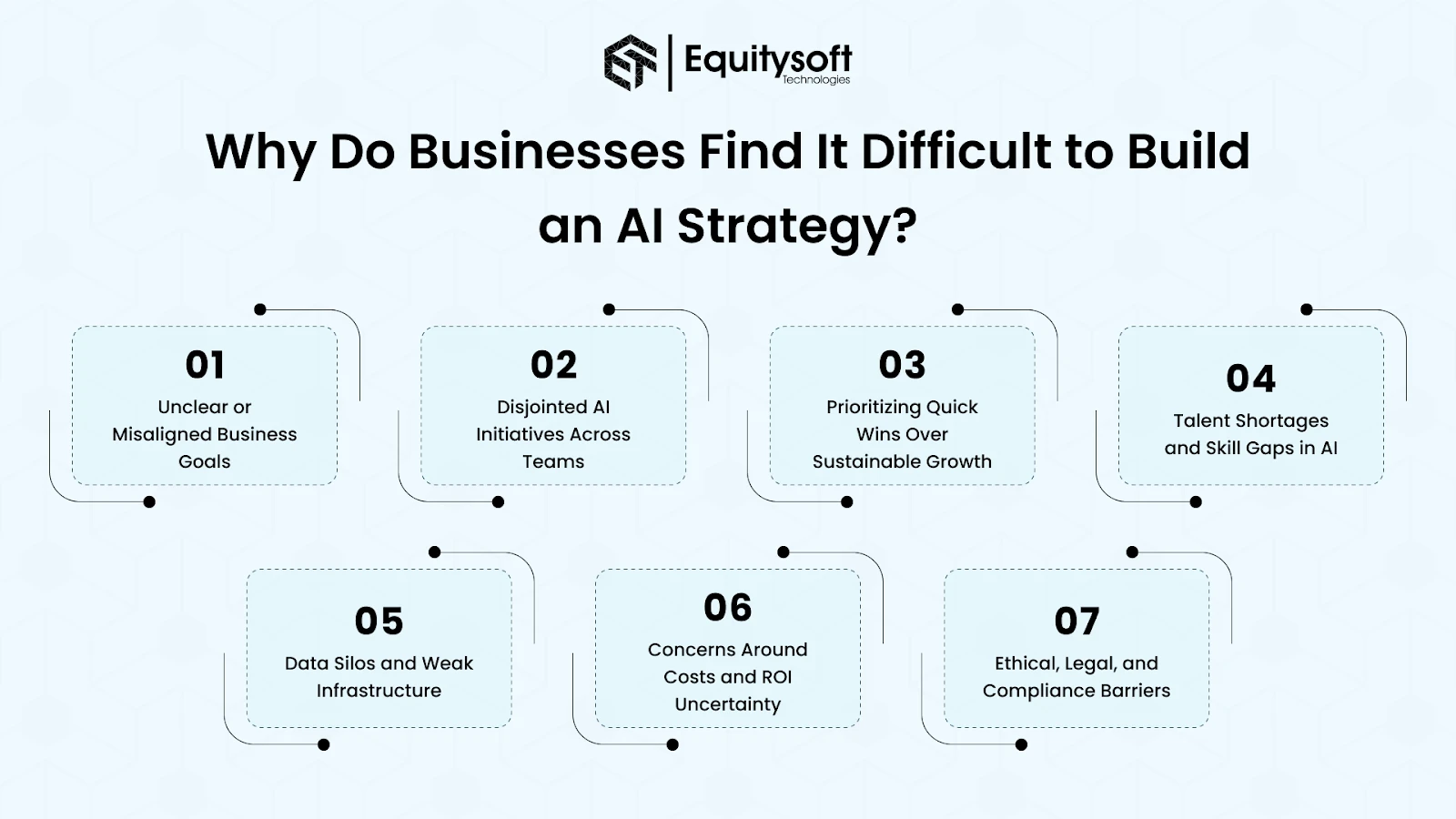AI is no longer a moonshot—it’s core to how modern businesses compete. Yet many organizations still adopt it reactively: because rivals are doing it, a vendor made a flashy pitch, or a department needed a quick fix. Those moves can deliver short-term wins, but they scatter AI across functions and prevent it from creating enterprise-level impact.
Real value comes from a company-wide strategy that ties AI to the business’s north-star objectives. With a clear AI strategy, every investment—from automation platforms to advanced analytics—ladder ups to long-term growth, operational efficiency, and durable competitive advantage. AI stops being a toolbox of disconnected experiments and becomes a strategic capability that fuels innovation across the organization.
So how do you move beyond ad-hoc adoption and build a structured, long-term AI strategy? Let’s break it down, step by step.

Why Do Businesses Find It Difficult to Build an AI Strategy?
Even though AI offers some of the most innovative opportunities for modern enterprises and startups alike, many organizations struggle when it comes to shaping a solid AI roadmap. The problem isn’t just about adopting the latest tools—it’s about aligning leadership goals, fostering the right culture, and ensuring smooth execution. Below are some of the major reasons businesses often hit roadblocks:
1. Unclear or Misaligned Business Goals
Many organizations jump into AI adoption without defining what problem they actually want to solve. Without clear KPIs or alignment with overall business objectives, AI projects often lose direction. Instead of improving efficiency or creating customer value, businesses end up experimenting with disconnected pilots that bring little impact.
2. Disjointed AI Initiatives Across Teams
AI adoption fails when different departments work in silos. Marketing, operations, and IT may all experiment with AI separately—leading to fragmented strategies, duplicate efforts, and inconsistent results. A unified, company-wide approach ensures that AI integrates seamlessly across workflows and supports collective growth.
3. Prioritizing Quick Wins Over Sustainable Growth
Short-term experiments may deliver quick ROI, but they rarely scale. Many businesses focus on immediate gains—like automating small tasks—without building a roadmap for long-term digital transformation. This reactive mindset prevents AI from becoming a sustainable competitive advantage.
4. Talent Shortages and Skill Gaps in AI
AI success depends on skilled professionals—data scientists, ML engineers, and AI strategists. But the global talent shortage means companies often lack the expertise to deploy and maintain AI solutions effectively. Without proper training or external partnerships, organizations struggle to move beyond pilot phases.
5. Data Silos and Weak Infrastructure
AI thrives on quality data, but many enterprises face messy, incomplete, or siloed datasets. In addition, outdated infrastructure makes it difficult to process large volumes of information in real time. These limitations restrict AI’s potential to deliver accurate insights and hinder scalability.
6. Concerns Around Costs and ROI Uncertainty
Adopting AI often appears costly due to investment in tools, cloud infrastructure, and skilled professionals. Businesses hesitate because they fear uncertain ROI. The key challenge lies in balancing upfront investment with a clear roadmap that demonstrates long-term value and measurable outcomes.
7. Ethical, Legal, and Compliance Barriers
From bias in algorithms to data privacy regulations, AI adoption brings a range of ethical and legal concerns. Organizations worry about compliance with evolving laws like GDPR, as well as public trust. A lack of responsible AI frameworks can slow down or even halt adoption.
Steps to Building a Robust AI Business Strategy
Crafting a strong AI strategy goes far beyond selecting the latest technologies—it’s about aligning innovation with business goals, creating the right infrastructure, and enabling a culture of adoption. Below is a structured step-by-step approach businesses can follow to transform AI from a buzzword into a true competitive advantage.
1. Define Clear Business Objectives
Before investing in AI, companies must first identify the challenges and opportunities AI should address. Too often, businesses adopt AI for the sake of appearing innovative rather than solving meaningful problems.
Ask questions such as:
- Where are the biggest inefficiencies in our operations?
- How can AI enhance customer experience?
- Can AI help us open new revenue streams?
By setting measurable KPIs—such as reducing churn by 15% or improving process efficiency by 20%—leaders can track AI’s real impact and keep projects aligned with broader business priorities.
2. Conduct a Comprehensive Data Audit
AI thrives on data, but poor-quality or inaccessible datasets can derail even the most ambitious strategy. Conducting a data audit helps identify what information is available, where it’s stored, and whether it’s ready for AI use.
Key considerations include:
- Data availability: Assess both structured data (CRM, ERP, databases) and unstructured data (emails, social media, customer support logs).
- Data quality: Clean missing, duplicate, or outdated records.
- Data integration: Break down silos across departments and unify information under a common framework.
If gaps exist, businesses can bridge them through partnerships, third-party data providers, or improved internal collection systems.
3. Explore AI Technologies and Their Use Cases
Not all AI solutions deliver the same value. Companies need to identify the technologies that align best with their unique priorities:
- Machine Learning (ML): Predictive analytics, fraud detection, recommendation engines.
- Natural Language Processing (NLP): Chatbots, sentiment analysis, customer support automation.
- Computer Vision: Quality control, facial recognition, autonomous systems.
- Robotic Process Automation (RPA): Automating repetitive, rule-based tasks.
The goal is not to chase trends, but to evaluate which AI applications solve real problems and deliver measurable ROI.
4. Assess Organizational Readiness
AI adoption is as much about people and processes as it is about technology. Businesses must evaluate their readiness across three dimensions:
- Technology: Do you have scalable infrastructure such as cloud platforms to support AI deployments?
- Talent: Do you employ or partner with AI engineers, data scientists, and specialists—or do you need to invest in hiring or upskilling?
- Culture: Are employees prepared to embrace AI-driven workflows? Clear communication and change management are essential to overcome resistance.
5. Develop an Ethical and Governance Framework
AI brings challenges around fairness, transparency, and compliance. A robust governance framework ensures AI systems are used responsibly while maintaining trust with stakeholders.
This should include:
- Ethical guidelines: Prevent bias and ensure algorithms are explainable.
- Data governance policies: Clearly define how data is collected, stored, and used.
- Compliance adherence: Stay aligned with regulations like GDPR, CCPA, or industry-specific rules.
Responsible AI doesn’t just minimize risk—it strengthens credibility with customers, employees, and regulators.
6. Identify Strategic Partners and Vendors
Most organizations cannot build AI solutions entirely in-house. Instead, they rely on a mix of technology vendors, cloud providers, and consulting partners.
Examples include:
- Cloud infrastructure: AWS, Google Cloud, Microsoft Azure.
- AI platforms: IBM Watson, OpenAI, DataRobot.
- Consulting partners: Agencies and firms that guide AI implementation end-to-end.
Choosing the right partners accelerates adoption while reducing costs and execution risks.
7. Build a Comprehensive AI Roadmap
A well-structured roadmap ensures AI initiatives don’t remain pilot projects but scale into enterprise-wide impact. The roadmap should outline:
- Data strategy: Defining collection, integration, and governance.
- Model strategy: Choosing between off-the-shelf solutions and custom AI models.
- Infrastructure setup: Deciding on cloud vs. on-premise systems.
- Talent plan: Balancing hiring, training, and outsourcing.
- Implementation timeline: Combining quick wins with long-term projects.
This roadmap aligns all stakeholders and keeps execution tied to both immediate results and future goals.
8. Foster a Culture of AI Adoption
Technology alone doesn’t guarantee success—employees must be empowered to use AI effectively. Organizations should:
- Provide AI training to enhance literacy across teams.
- Create innovation labs or sandboxes to test new AI use cases.
- Highlight internal success stories to build excitement and buy-in.
By embedding AI into the company culture, businesses ensure that adoption happens at every level, not just in isolated teams.
9. Establish Continuous Governance and Compliance
AI systems need ongoing monitoring to stay effective and aligned with evolving laws. Businesses should set up dedicated oversight teams to track usage, conduct audits, and update models as new risks emerge.
With AI regulations still developing globally, proactive compliance ensures businesses stay ahead of risks rather than reacting to them.
10. Monitor, Measure, and Optimize
AI strategy is never “done.” Once solutions are in place, companies must measure outcomes against KPIs and continuously refine.
This includes:
- Tracking metrics like accuracy, cost savings, and revenue uplift.
- Updating algorithms as new data becomes available.
- Expanding AI to new functions as confidence grows.
Continuous optimization transforms AI into a long-term growth driver rather than a one-time experiment.
Choosing the Right AI Tech Stack for Your Business
Adopting AI is more than just picking the right tools—it requires cultural, financial, and strategic shifts.
Businesses often face hurdles that can slow down or even derail AI initiatives.
Here are the most common challenges and how to overcome them:

1. Resistance to Change & Lack of Employee Buy-In
AI often changes the way teams work, which can create fear and resistance among employees—especially if they worry about job security. Without proper communication and involvement, adoption rates suffer.
Why it’s a challenge:
- Employees may hesitate to embrace AI tools.
- Misunderstandings about AI replacing humans fuel fear and uncertainty.
How to solve it:
- Position AI as a tool that enhances—not replaces—human work.
- Involve employees early in the AI journey and provide training.
- Share success stories of AI boosting productivity and decision-making.
2. High Costs & Unclear ROI
Building and deploying AI solutions often demand heavy investments in infrastructure, talent, and software. Many businesses hesitate due to uncertain returns.
Why it’s a challenge:
- AI projects can take months or years before showing results.
- Hidden costs like storage, computing power, and retraining models can escalate budgets.
How to solve it:
- Begin with small-scale pilots before expanding organization-wide.
- Leverage cloud-based AI to minimize upfront costs.
- Measure success with KPIs such as efficiency gains, revenue growth, or cost savings.
3. Ethical & Regulatory Concerns
AI introduces risks around bias, privacy, and compliance. With stricter regulations emerging globally, businesses must stay ahead to avoid penalties and reputational damage.
Why it’s a challenge:
- Algorithms can unintentionally reinforce bias if trained on skewed data.
- Privacy laws like GDPR and CCPA enforce strict rules on AI-driven data use.
How to solve it:
- Follow ethical AI principles—fairness, transparency, and accountability.
- Regularly conduct AI bias audits.
- Stay updated on regulations and ensure compliance in all implementations.
4. Difficulty in Scaling AI Across the Business
Many companies succeed with AI in one area but struggle to replicate that success across departments.
Why it’s a challenge:
- AI models often don’t transfer seamlessly between use cases.
- Scaling requires more infrastructure, integration, and employee training.
How to solve it:
- Design AI solutions with scalability in mind.
- Standardize workflows and implement AI governance frameworks.
- Encourage collaboration between departments for smoother adoption.
5. Unrealistic Expectations & Overhype
AI is often marketed as a silver bullet, leading businesses to expect immediate transformations. In reality, AI adoption is iterative and requires patience.
Why it’s a challenge:
- Overpromises create inflated expectations.
- Businesses may abandon AI too early if results aren’t instant.
How to solve it:
- Set clear timelines and realistic milestones.
- Track incremental improvements instead of chasing overnight success.
- Educate leadership on what AI can and cannot do.
Building a Sustainable AI Strategy
Success with AI isn’t about quick wins—it’s about building a foundation that balances technology, people, and processes. Organizations that proactively tackle these challenges position themselves for long-term competitive advantage.
How Can Equitysoft Technologies Help You Build an AI Business Strategy?
Equitysoft Technologies, a trusted AI development company, has been at the forefront of enabling businesses worldwide to adopt AI with confidence and clarity. With years of experience delivering impactful technology solutions, we specialize in creating AI strategies that are practical, scalable, and result-driven. From ambitious startups to established enterprises, our team partners with organizations to identify high-value AI opportunities, design robust models, and integrate them seamlessly into their existing workflows. Whether your goal is to enhance customer experience, streamline operations, or unlock entirely new revenue streams, our AI consulting services ensure that AI becomes a true growth enabler for your business.
How Do We Do It?
We simplify the complex journey of AI adoption by aligning technology initiatives directly with your business goals. Here’s how we help:
- Deep Business Understanding – We begin by analyzing your unique challenges, objectives, and processes to ensure AI supports your long-term vision.
- Data & Infrastructure Audit – Our experts assess your current data, systems, and IT ecosystem to build AI solutions on a strong, future-ready foundation.
- Right Technology Selection – From machine learning and predictive analytics to natural language processing and AI-powered automation, we help you choose the right technologies tailored to your needs.
- Seamless Integration – We design AI applications that work smoothly within your existing systems, ensuring minimal disruption and maximum efficiency.
- Upskilling & Training – Beyond implementation, we empower your teams with AI knowledge, providing training and resources to foster AI fluency across your organization.
- Ethical & Transparent AI – At every stage, we prioritize ethical AI practices, focusing on fairness, privacy, and accountability in decision-making.
- Continuous Support – With a flexible and adaptive strategy, we ensure your AI ecosystem evolves with changing business demands and industry advancements.
With our end-to-end AI consulting and development expertise, Equitysoft Technologies helps transform your vision into actionable results, positioning your business for long-term competitive advantage.
🚀 Ready to build your AI business strategy? Let’s work together to turn your AI aspirations into measurable success. Contact Equitysoft Technologies today.
FAQs on AI Business Strategy
Everything Businesses Need to Know About AI Strategy & Adoption




